Description:
Antonym Directions: In each of the following antonym questions, a work printed in capital letters precedes five lettered words or phrases. From these five lettered words or phrases, pick the one most nearly opposite in meaning to the capitalized word. 1. PRODIGAL:
(A) nomad
(B) sycophant
(C) gifted child | (D) economical person
(E) antagonist |
2. ARTIFICE:
(A) edifice
(B) sincerity
(C) prejudice | (D) creativity
(E) affirmation |
Sentence Completion Directions: Each of the following sentence completion questions contains one or two blanks. These blanks signify that word or set or works has been left out. Below each sentence are five words or sets of words. For each blank, pick the word or set of words that best reflects the sentence's overall meaning. 3. The earth is a planet bathed in light; it is therefore ----- that many of the living organisms that have evolved on the earth have ----- the biologically advantageous capacity to trap light energy. (A) anomalous...engendered
(B) unsurprising...developed
(C) predictable...forfeited
(D) problematic...exhibited
(E) expectable...relinquished 4. Relatively few politicians willingly forsake center stage, although a touch of --- on their parts now and again might well increase their popularity with the voting public.
(A) garrulity
(B) misanthropy
(C) self-effacement | (D) self-dramatization
(E) self-doubt |
Analogy Directions: Each of the following analogy questions presents a related pair of words linked by a colon. Five lettered pairs of words follow the linked pair. Choose the lettered pair of words whose relationship is most like the relationship expressed in the original linked pair. 5. CIRCUITOUS : ROUTE ::
(A) problematic : solution
(B) devious : argument?
(C) gullible : incredulous | (D) enigmatic : dumbfounded
(E) deferential : sycophantic |
Reading Comprehension Directions: Each of the following reading comprehension questions is based on the content of the following passage. Read the passage and then determine the best answer choice for each question. Base your choice on what this passage states directly or implies, not on any information you may have gained elsewhere. Jame's first novels used conventional narrative techniques: explicit characterization, action which related events in distinctly phased sequences, settings firmly outlined and specifically described. But this method gradually have way to a subtler, more deliberate, more diffuse style of accumulation of minutely discriminated details whose total significance the reader can grasp only by constant attention and sensitive inference. His later novels play down scenes of abrupt and prominent action, and do not so much offer a succession of sharp shocks as slow piecemeal additions of perception. The curtain is not suddenly drawn back from shrouded things, but is slowly moved away. Such a technique is suited to Jame's essential subject, which is not human action itself but the states of mind which produce and are produced by human actions and interactions. James was less interested in what characters do, than in the moral and psychological antecedents, realizations, and consequences which attend their doings. This is why he more often speaks of "cases" than of actions. His stories, therefore, grow more and more lengthy while the actions they relate grow simpler and less visible; not because they are crammed with adventitious and secondary events, digressive relief, or supernumerary characters, as overstuffed novels of action are; but because he presents in such exhaustive detail every nuance of his situation. Commonly the interest of a novel is in the variety and excitement of visible actions building up to a climatic event which will settle the outward destinies of characters with storybook promise of permanence. A James novel, however, possesses its characteristic interest in carrying the reader through a rich analysis of the mental adjustments of characters to the realities of their personal situations as they are slowly revealed to them through exploration and chance discovery. 7. The passage supplies information for answering for answering which of the following questions? (A) Did James originated information for answering which of the following questions?
(B) Is conventional narrative techniques strictly chronological in recounting action?
(C) Can novels lacking overtly dramatic incident sustain the reader's interest?
(D) Were Jame's later novels more acceptable to the general public than his earlier ones?
(E) Is James unique in his predilection for exploring psychological nuances of character? 8. According to the passage, Jame's later novels differ from his earlier ones in their (A) preoccupation with specifically described settings
(B) ever-increasing concision and tautness of plot
(C) levels of moral and psychological complexity
(D) development of rising action to a climax
(E) subordination of psychological exploration to dramatic effect 9. The author's attitude toward the novel of action appears to be one of
(A) pointed indignation
(B) detached neutrality
(C) sharp derision | (D) strong partisanship
(E) mild disapprobation |
Antonyms 10. EQUIVOCATE:
(A) yield
(B) penury
(C) condescend | (D) pledge
(E) denounce |
11. OPULENCE:
(A) transience
(B) penury
(C) solitude | (D) generosity
(E) transparency |
Analogies 12. EPHEMERAL : PERMANENCE ::
(A) erratic : predictability
(B) immaculate : cleanliness
(C) commendable : reputation | (D) spurious : emulation
(E) mandatory : obedience |
13. NONPLUSSED : BAFFLEMENT ::
(A) discomfited : embarrassment
(B) parsimonious : extravagance
(C) disgruntled : contentment | (D) despicable : contempt
(E) surly : harassment |
14. OGLE : OBSERVE ::
(A) haggle : outbid
(B) clamor : dispute
(C) discern : perceive? | (D) flaunt : display
(E) glare : glower |
Sentence Completion 15. It may be useful to think of character in fiction as a function of two ---- impulses: the impulse to individualize and the impulse to ----. (A) analogous...humanize
(B) disparate...aggrandize
(C) divergent...typify
(D) comparable...delineate
(E) related...moralize 16. There are any number of theories to explain these events and, since even the experts disagree, it is ---- the rest of us in our role as responsible scholars to ---- dogmatic statements. (A) paradoxical for...abstain from
(B) arrogant of...compensate from
(C) incumbent on...refrain from
(D) opportune for...quarrel over
(E) appropriate for...issue forth Reading Comprehension According to the theory of plate tectonics, the lithosphere (earth's relatively hard and solid outer layer consisting of the crust and part of the underlying mantle) is divided into a few dozen plates that vary in size and shape; in general, these plates move in relation to another. They move away from one another at a mid-ocean ridge, a long chain of sub-oceanic mountains that forms a boundary between plates. At a mid-ocean ridge, new lithosphere material in the form of hot magma pushes up from the earth's interior. the injection of this new lithospheric material from below causes the phenomenon known as sea-floor spreading. Given that the earth is not expanding in size to any appreciable degree, how can "new" lithosphere be created at a mid-ocean ridge? For new lithosphere material must be destroyed somewhere else. This destruction takes place at a boundary between plates called a subduction zone. At a subduction takes place at a boundary between plates called a subduction zone. At a subduction zone, one plate is pushed down under another into the red-hot mantle, where over a span of millions of years it is absorbed into the mantle. In the early 1960's, well before scientists had formulated the theory of plate tectonics, Princeton University professor Harry H. Hess proposed the concept of sea-floor spreading. Hess's original hypothesis described the creation and spread of ocean floor by means of the upwelling and cooling of magma from the earth's interior. Hess, however, did not mention rigid lithospheric plates. The subsequent discovery that the oceanic crust contains evidence of periodic reversals of the earth's magnetic field helped confirm Hess' hypotheses. According to the explanation formulated by Princeton's F.J. Vine and D.H. Matthews, whenever magma wells up under a mid-ocean ridge, the ferromagnetic minerals within the magma become magnetized in the direction of the geomagnetic field. As the magma cools and hardens into dock, the direction and the polarity of the geometric field are recorded in the magnetized volcanic rock. Thus, when reversals of the earth's magnetic field occur, as they do at intervals of from 10,000 to around a million years, they produce a series of magnetic stripes paralleling the axis of the rift. Thus, the oceanic crust is live a magnetic tape recording, but instead of preserving sounds or visuals images, it preserves the history of earth's geomagnetic field. the boundaries between stripes reflect reversals of the magnetic field; these reversals can be dated independently. Given this information, geologists can deduce the rate of sea-floor spreading from the width of the stripes. (Geologists, however, have yet to solve the mystery of exactly how the earth's magnetic fields comes to reverse itself periodically.) 17. According to the passage, a mid-ocean ridge differs from a subduction zone in that (A) it marks the boundary line between neighboring plates
(B) only the former is located on the ocean floor
(C) it is a site for the emergence of new lithospheric material
(D) the former periodically distrupts the earth's geomagnetic field
(E) it is involved with lithospheric destruction rather than lithospheric creation 18. It can be inferred from the passage that a new lithospheric material in injection from below (A) the plates become immobilized in a kind of gridlock
(B) it is incorporated into an underwater mountain ridge
(C) the earth's total mass is altered
(D) it reverses its magnetic polarity
(E) the immediately adjacent plates sink 19. According to the passage, lithospheric material at the site of a subduction zone (A) rises and it polarized
(B) sinks and is reincorporated
(C) slides and is injected
(D) spreads and is absorbed
(E) diverges and is consumed Antonyms 20. HONE:
(A) broaden
(B) twist
(C) dull | (D) weld
(E) break |
21. PHLEGMATIC:
(A) dogmatic
(B) ardent
(C) haphazard | (D) self-assured
(E) abstracted |
22. BANALITY:
(A) tentative interpretation
(B) concise summation
(C) accurate delineation | (D) laundatory remark
(E) novel expression |
Analogies 23. THIRST : DRIVE ::
(A) inebriety : excess
(B) success : ambition
(C) indifference : passion | (D) taste : gusto
(E) smell : sense |
24. SKULDUGGERY : SWINDLER ::
(A) surgery : quack
(B) quandary : craven
(C) chicanery : trickster | (D) forgery : speculator
(E) cutlery : butcher |
Sentence Completion 25. According to one optimistic hypothesis, the dense concentraion of entrepreneurs and services in the cities would incubate new functions, ---- them, and finally export them to other areas, and so the cities, forever breeding fresh ideas, would ---- themselves repeatedly.
(A) immunize...perpetuate
(B) isolate...revitalize
(C) foster...deplete | (D) spawn...imitate
(E) nurture...renew |
26. Man is a ---- animal, and much more so in his mind than in his body: he may like to go alone for a walk, but he hates to stand alone in his ----.
(A) gregarious...opinions
(B) conceited...vanity
(C) singular...uniqueness | (D) solitary...thoughts
(E) nomadic...footsteps |
Antonyms 27. ERUDITE:
(A) unhealthy
(B) ignorant
(C) impolite | (D) indifferent
(E) imprecise |
28. EFFRONTERY:
(A) obscurity
(B) indolence
(C) separation | (D) diffidence
(E) fluctuation |
Reading Comprehension The stability that had marked the Iroquois Confederacy's generally pro-British position was shattered with the overthrow of James II in 1688, the colonial uprisings that followed in Massachusetts, New York, and Maryland, and the commencement of King William's War against Louis XIV of France. The increasing French threat to English hegemony in the interior of North America was signalized by French-led or French-inspired attacks on the Iroquois and on outlying colonial settlements in New York and New England. The high point of the Iroquois response was the spectacular raid of August 5,1689, in which the Iroquois virtually wiped out the French Village of Lachine, just outside Montreal. A counterraid by the French on the English village of Schenectady in March, 1690, instilled an appropriate measure of fear among the English and their Iroquois allies. The Iroquois position at the end of the war, which was formalized by treaties made during the summer of 1701 with the British and the French, and which was maintained throughout most of the eighteenth century, was one of "aggressive neutrality" between the two competing European powers. Under the new system the Iroquois initiated a peace policy toward the "far Indians," tightened their control over the nearby tribes, and induced both English and French to support their neutrality toward the European powers by appropriate gifts and concessions. By holding the balance of power in the sparsely settled borderlands between English and French settlements, and by their willingness to use their power against one or the other nation if not appropriately treated, the Iroquois played the game of European power politics with effectiveness. The system broke down, however, after the French became convinced that the Iroquois were compromising the system in favor of the English and launched a full-scale attempt to establish French physical and juridical presence in the Ohio Valley, the heart of the borderlands long claimed by the Iroquois. As a consequence of the ensuing Great War for Empire, in which Iroquois neutrality was dissolve and European influence moved closer, the play-off system lost its efficacy and a system of direct bargaining supplanted it. 29. The author's primary purpose in this passage is to (A) denounce the imperialistic policies of the French
(B) disprove the charges of barbarism made against the Indian nations
(C) expose the French government's exploitation of the Iroquois balance of power
(D) describe and assess the effect of European military power on the policy of an Indian nation
(E) show the inability of the Iroquois to engage in European-style diplomacy 30. With which of the following statements would the author be LEAST likely to agree? (A) The Iroquois were able to respond effectively to French acts of aggression.
(B) James II's removal from the throne caused dissension to break out among the colonies.
(C) The French begrudged the British their alleged high standing among the Iroquois.
(D) Iroquois negotiations involved playing one side against the other.
(E) The Iroquois ceased to hold the balance of power early in the eighteenth century. Section 2 - Qualitative Ability
28 Questions - 45 Minutes Quantitative Comparison Directions: In the following type of question, two quantities appear, one in Column A and one in Column B. You must compare them. The correct answer to the question is
| A if the quantity in Column A is greater
B if the quantity in Column B is greater
C if the two quantities are equal
D if it is impossible to determine which quantity is greater |
Notes: Sometimes information about one or both of the quantities is centered above the two columns. If the same symbol appears in both columns, it represents the same thing each time.
| Column A | Column B |
| 1. | a > 0 |
| | |
| |
|  |
| 2. | | |
|
|
|
| 3. |
The number of primes between 30 and 40 |
|
The number of primes between 40 and 50 |
|
Discrete Quantitative and Data Interpretation Directions: In the following questions, choose the best answer from the five choices listed. 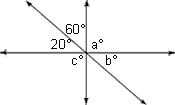
5. In the figure at the right, what is the value of a + b + c?
(A) 210
(B) 220
(C) 240 | (D) 270
(E) 280 |
6. Of the 200 seniors at Monroe High School, exactly 40 are in the band, 60 are in the orchestra, and 10 are in both. How many students are in neither the band nor the orchestra?
(A) 80
(B) 90
(C) 100 | (D) 110
(E) 150 |
7. Twenty children were sharing equally the cost of a present for their teacher. When 4 of the children decided not to contribute, each of the other children had to pay $ 1.50 more. How much did the present cost, in dollars?
(A) 50
(B) 80
(C) 100 | (D) 120
(E) 150 |
Quantitative Comparison
| Column A | Column B |
| 8. | a > 0 |
| | |
| |
| There are 250 people lined up outside a theater. Jack is the 25th person from the front, and Jill is the 125th person from the front. |
| 9. |
The number of people between Jack and Jill |
| |
Data Interpretation 10. What is the value of n if 310 X 272 = 92 X 3n?
(A) 6
(B) 10
(C) 12 | (D) 15
(E) 30 |
Quanitative Comparison
| Column A | Column B |
| 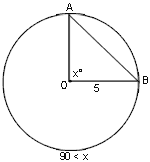 |
| 11. | | |
| a-b/c-a = 1 |
| 12. |
The average (arithmetic mean) of b and c |
| |
|
|
|
| 13. |
The area of a square whose sides are 10 |
|
The area of a square whose diagonals are 15 |
|
Data Interpretation: Questions 14-15 refer to the graph below. Popular Vote Cast for President
by Major Political Parties
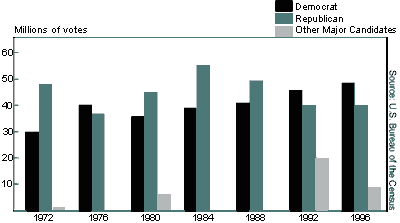 14. In which presidential election between 1972 to 1996 inclusive, was the percent of votes received by the winning candidate the lowest?
(A) 1976
(B) 1980
(C) 1988 | (D) 1992
(E) 1996 |
15. In which year between 1972 and 1996 inclusive were the greatest number of votes cast for president?
(A) 1980
(B) 1984
(C) 1988 | (D) 1992
(E) 1996 |
Discrete Quantitative 16. In 1990, twice as many boys as girls at Adams High School earned varsity letters. From 1990 to 2000 the number of girls earning varsity letters increased by 25% while the number of boys earning varsity letters decreased by 25%. What was the ratio in 2000 of the number of girls to the number of boys who earned varsity letters?
(A) 5/3
(B) 6/5
(C) 1/1 | (D) 5/6
(E) 3/5 |
Quantitative comparison
| Column A | Column B |
| 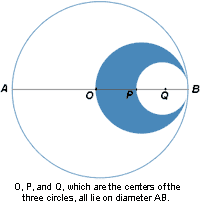 |
| 17. |
The area of the entire white region |
|
4 times the area of blue region |
|
| Column A | Column B |
| In 1980, Elaine was 8 times as old as Adam, and Judy was 3 times as old as Adam. Elaine is 20 years older than Judy. |
| 18. | | |
| Column A | Column B |
| 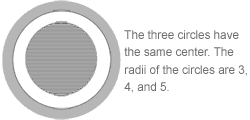 |
| 19. |
The area of the shaded region |
|
The area of the striped region |
|
Discrete Quantitative 21. A square and an equilateral triangle each have sides of length 5. What is the ratio of the area of the square to the area of the triangel?
(A) 4/3
(B) 16/9
(C) √3/4
| (D) 4√3/3
(E) 16√3/9 |
22. If x + 2y = a and x - 2y = b, which of the following expressions is equal to xy? (A) ab
(B) a + b/2
(C) a - b/2
(D) a2 - b2/4
(E) a2 - b2/8 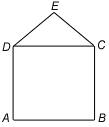
23. In the figure above, the area of square ABCD is 100, the area of triangle DEC is 10, and EC. What is the distance from A to E?
(A) 11
(B) 12
(C) √146 | (D) 13
(E) √244 |
Section 3 - Analytical Writing
Time - 75 Minutes 2 Writing Tasks Task 1 : Issue Exploration - 45 Minutes Directions: In 45 minutes, choose one of the two following topics and compose an essay on that topic. You may not write on any other topic. Write your essay on separate sheets of paper. Each topic is presented in a one - to two - sentence quotation commenting on an issue of general concern. Your essay may support, refute, or qualify the views expressed in the quotation. Whatever you write, however, must be relevant to the issue under discussion, and you must support your viewpoint with reasons and examples derived from your studies and/or experience. Before you choose a topic, consider which would give you greater scope for writing an effective, well-argued essay. Your essay will be judged on the basis of your skill in the following areas. - Analysis of the quotation's implications
- Organization and articulation of your ideas
- Use of relevant examples and arguments to support your case
- Handling of the mechanics of standard written English
Once you have decided which topic you prefer, click on the appropriate icon to confirm your choice. Do not be hasty confirming your choice of topic. Once you have clicked on a topic, you will not be able to switch to the alternate choice. Topic 1 "We venerate loyalty---to our schools, employers, institutions, friends---as a virtue, Loyalty, however, can be at least as detrimental an influence as it can be a beneficial one." Topic 2 "A person who does not thoroughly comprehend the technical side of a craft is incapable of judging it." Task 2: Argument Analysis - 30 Minutes Directions: In 30 minutes, prepare a critical analysis of an argument expressed in a short paragraph. You may not offer an analysis of any other argument. Write your essay on separate sheets of paper. As you critique the argument, think about the author's underlying assumptions. Ask yourself whether any of them are questionable. Also evaluate any evidence any evidence the author brings up. Ask yourself whether it actually supports the author's conclusion. In your analysis, you may suggest additional kinds of evidence to reinforce the author's argument. You may also suggest methods to refute the argument, or additional data that might be useful to you as you assess the soundness of the argument. You may not, however, present your personal views on the topic. Your job is to analyze the elements of an argument, not to support of contradict that argument. Faculty members from various institutions will judge your essay, assessing it on the basis of your skill in the following areas: - Identification and assessment of the argument's main elements
- Organization and articulation of your thoughts
- Use of relevant examples and arguments to support your case
- Handling of the mechanics of standard written English
The following appeared in an editorial in the Bayside Sentinel.
"Bayside citizens need to consider raising local taxes if they want to see improvements in the Bayside School District. Test scores, graduation and college admission rates, and a number of other indicators have long made it clear that the Bayside School District is doing a poor job education our youth. Our schools look run down. Windows are broken, bathrooms unusable, and classroom equipment hopelessly out of date. Yet just across the Bay, in New Harbor, school facilities are up-to-date and in good condition. The difference is money; New Harbor spends twenty-seven percent more per student than Bayside does, and test scores and other indicators of student performance are stronger in New Harbor as well. |
| 







Share your views...
0 Respones to " "
Post a Comment